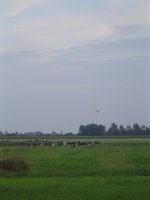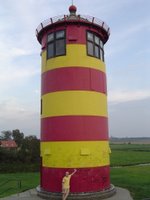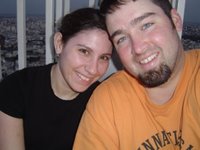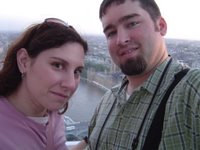
I am here to work after all. So, I thought I’d provide an explanation of what I’m doing on this highly enjoyable “business trip.” Given the number of blank stares I’ve received when using the phrase image analysis, I think it’s a worthwhile endeavor.
The beautiful picture you see above is a microscopic image of sludge flocs. What’s a sludge floc? It is several hundreds of bacteria who have glued themselves together with proteins and starches. I have carefully cultured these sludge flocs in the lab in an attempt to understand bacterial psychology. Why have they chosen this particular recipe of proteins and starches for their glue? Why do they grow in flocs of that shape and size? Why do they grow as flocs at all, can’t they fend for themselves?
Of course I can’t ask my bacteria these questions (although I do talk to them from time to time) so I have to find some tools to study their habits. Throughout their life in my biological reactors, I’ve taken many thousands of microscopic images of my sludge flocs to observe changes in their size and shape. I don’t want to manually summarize how my flocs have changed, I'd rather have my computer do the work for me.
First, I enhance the contrast of my image to make the sludge flocs stand out from the background. (1) Enhanced contrast.
(1) Enhanced contrast.
Then, I convert this enhanced picture into a binary image where all the visual information is represented as zeros and ones. At every pixel, the computer asks Is this a sludge floc? If the answer is yes, the pixel is labeled with a 1; if no, zero.
Once I have a good binary image, I can do things like separating filamentous organisms and filling in the holes to get a solid representation of my flocs.
 (3) Floc structure characterization
(3) Floc structure characterization
If you’ve read this far, you probably now know more than you really wanted about image analysis of sludge flocs. But, I find the sludge flocs used for biological wastewater treatment infinitely fascinating. Hence the reason why I’m getting my PhD is this area. Little did my father know how much influence he could have over my career path. Or maybe that was his plan all along? He did take my girl scout troop on a tour of the town’s wastewater treatment plant.
 (2) Binary Image
(2) Binary Image







 An example of a bunker with a new use
An example of a bunker with a new use a German water tower
a German water tower just a cool pic of a wind turbine
just a cool pic of a wind turbine
































3 Comments:
Hi Adrienne,
It's your dad trying to leave a message.
It was good talking to you this morning.
I tryed to leave two comments however they didn't go.
I am glade to see you got to see your uncle while you were in europe.
Your mother said to bye whatever you want at one of the flea market you are going to and she will send Jeff the cash for your birthday.
She didn't tell me anything about a spending limit. However we all know that there surly is one.
Love Dad
Hi Adrienne,
I see that they have Water Bears in Franch Sludge too. They must also have an I&I problems as well.
Do you remember your first science fair project when you were a freshman in hign school.
Who would think after 12 years of school you would still be working on your science fair project.
Love Dad
Hello Dad,
I wondered if you'd notice that image of a water bear. Actually, the water bear is in my reactor, which I started with sludge from Danville. I surely don't have I&I in the lab unless my undergraduates have been doing strange things when I'm not paying attention.
So, now maybe you understand more what it means go a PhD. It's a very, very large science fair project which I am paid to complete. Once I've done enough research to publish 3 journal articles, my advisor will let me graduate. Taking classes is just an added benefit (or burden depending on how you look at).
I'll let you know if I find something at a flea market. The problem actually isn't finding something I want but getting the treasure home. Its not so inexpensive to ship things.
Love ya,
Adrienne
Post a Comment
<< Home